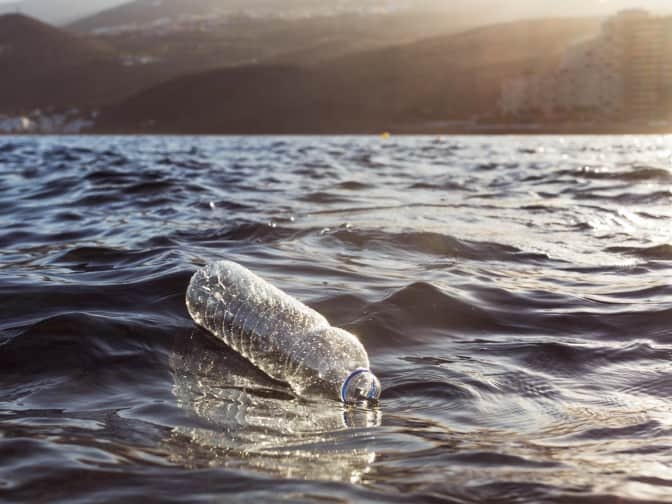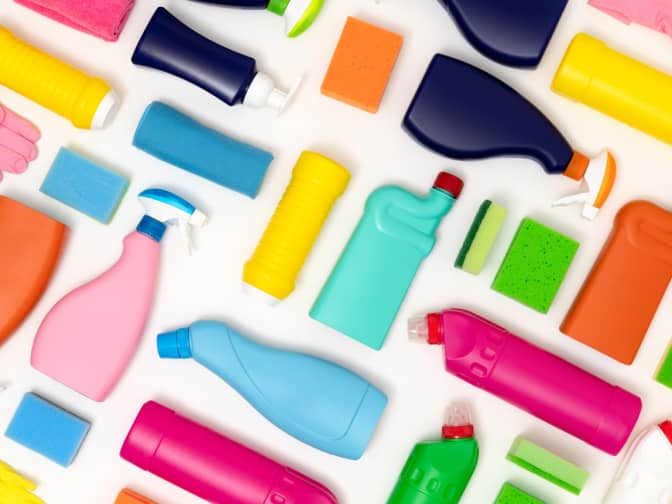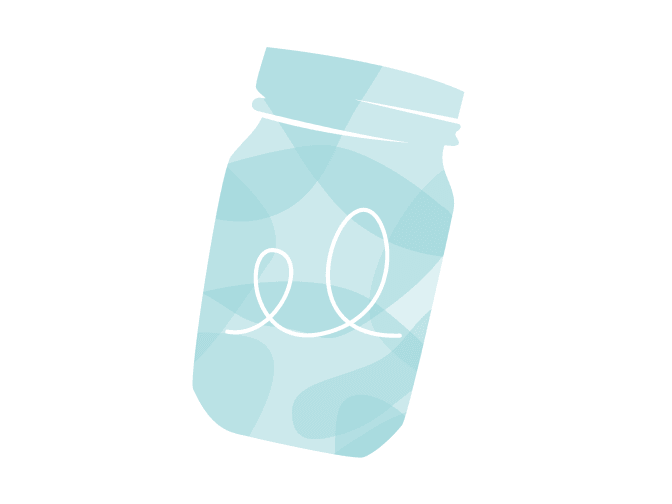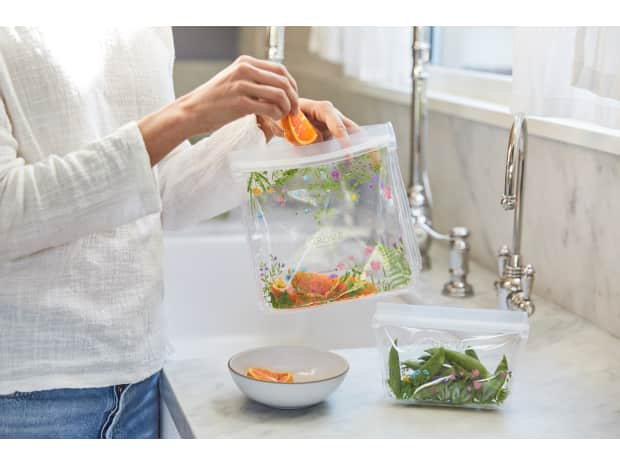2. Invest in sustainable food storage and organizational systems.
Try reusable bags and containers made from metal or glass.


Last Updated: March 15, 2022
Recyclable plastic packaging is a myth; here’s why plastic recycling doesn’t work.
You can find recycling symbols (chasing arrows) on everything from soda bottles to detergent containers and the little plastic clamshells of fresh berries at the grocery store, but how much of the plastic we use every day is actually being recycled?
The answer is distressing: According to the Environmental Protection Agency (EPA), less than 9% of plastic gets recycled in the U.S.—no matter how much you put into your recycling bin.
Despite increased public awareness, promises by major corporations to “go green,” and even legislation limiting the use of certain kinds of single-use plastics, the world is in the midst of a plastic pollution crisis. The concept of “recycled plastic” seems to promise a way out, but plastic recycling is largely a myth.
What’s really happening to all of that so-called recyclable plastic? Keep reading to learn more about the truth of plastic pollution and what Grove Collaborative is doing to fight back.

Plastic recycling bins, plastic bag bans, and the growing use of reusable straws might make it seem like there’s a collective effort to get the plastic crisis under control. The reality is that plastic production is rapidly expanding, rather than contracting.
Worldwide, more than 348 million tons of plastic are produced annually, and about half of that ends up as waste. Since 2019, 42 new U.S. plastic plants have either completed construction or were permitted for development, and the U.S. currently ranks second in the world for plastic production.
Despite state and city laws that ban them, one million plastic bags are still used each minute in the U.S., and big oil companies have used the push for electric cars and other “clean” goods as an opportunity to shift toward more plastic production, not less.
The biggest problem with all of this plastic is that it never disappears. The volume of plastic now polluting the oceans is between 75–199 million metric tons, and some organizations estimate there could be more plastic in the ocean than fish by 2050. You might picture empty bottles and used toothbrushes floating in the open water, but the biggest threat is actually tiny particles of plastic called microplastics.
Environmental factors like sunlight, currents, and wind break plastic down into pieces smaller than rice grains that end up being ingested by wildlife sometimes even consumed by humans. These tiny plastic particles are impossible to filter out and their numbers grow by the day.
Corporations that manufacture consumer product goods play the biggest role in contributing to the global plastic pollution crisis. More than 76 million pounds of plastic packaging are created by U.S. companies every single day, and major brands like Coca-Cola, Pepsi Co., Nestle, Unilever, and others hold spots as top plastic polluters.
Over the past several decades, plastic has taken over the consumer goods industry because it is cheap to produce, convenient to use, and disposable. As concern over plastic production and waste has mounted, many brands and government agencies have promoted the idea that single-use plastic goods are OK because plastic is recyclable.
But, according to a report by NPR, plastic industry officials knew as early as the 1970s that plastic recycling was not an efficient or even achievable means of dealing with the plastic crisis.
A steady campaign of misinformation has led the majority of Americans to think plastic recycling is a viable option when, in reality, it isn’t. A poll by the nonprofit Consumer Action found that nearly a third of Americans mistakenly believe plastic is the most recyclable packaging material and 58% believe plastics can be recycled indefinitely.
Because so many people believe in the myth of plastic recycling, the majority of Americans also say they rely on brands to ensure their packaging is recyclable. Meanwhile, brands continue to tout their products as being recyclable and put the onus back on consumers to ensure plastic waste makes it into the recycling bin.
But both sides of this debate are missing an important truth: Plastic recycling doesn’t work.

The short answer is no, plastic cannot be completely recycled in perpetuity.
Plastic recycling requires energy, time, money, labor, water, and the proper facilities, and these resources are often too difficult to come by for plastic recycling to work on a large scale. Many kinds of plastic can’t be recycled at all, and even the plastics that are recyclable can only be recycled two to three times at most before the quality degrades to the point where the plastic is no longer usable. Plus, recycling plastic is expensive — if recycling a batch of plastics isn’t worthwhile for the recycling company, they will send it to the landfill or export it to other countries instead.
The most common plastics can be temporarily recycled into other products if they’re cleaned, disposed of properly, and sorted. For example, plastic #1, or polyethylene terephthalate, which is used in water bottles, can be recycled and incorporated into new containers.
The problem is that many of these plastics never make it to a recycling bin in the first place or the communities that are trying to recycle them lack the proper facilities and processes for plastic recycling to take place.
Like we said before, only 9% of plastic ends up being recycled. The rest ends up in landfills, incinerators, or as a part of the 14 million tons of discarded plastic polluting the world’s oceans. This is the result of a combination of two major obstacles to recycling: the economics of recycling and whether recyclers can actually generate a profit, coupled with insufficient recycling infrastructure in the U.S. The result is that most of our recycling gets shipped overseas, where leakage or pollution is more likely.
According to the most recently available data from the EPA, landfills receive about 27 million tons of plastic annually and 5.6 million tons of plastic are burned. Burning plastic releases toxic greenhouse gasses into the atmosphere, creates hazardous air pollution, and contaminates water for neighboring communities.
In fact, plastic production has been labeled by some organizations as “the new coal,” and emissions from plastic production are on track to outpace coal emissions by 2030.
Grove Tip
Ultimately, the widespread belief that plastic can be recycled is a form of wishcycling. Wishcycling is aspirational recycling, or the practice of throwing items into the recycling bin that can’t actually be recycled — hoping for the best. This mainly applies to anything except clean #1 or #2 plastic products. See our breakdown of the plastic recycling numbers here.
Wishcycling comes from good intentions. As we mentioned above, corporations and other organizations have worked hard to convince the public that recycling works, and thoughtful people want to do their part. But wishcycling can create contamination issues at recycling facilities, actually preventing goods from getting recycled. Believe it or not, it’s better to throw something in the trash — especially any plastics that aren’t #1, 2, or 5 — then it is to contaminate recyclables.
Wishcycling is ultimately just that: a wish. At Grove, we’ve extended our definition of wishcycling to include any form of plastic recycling, and that’s why we’re committed to being 100% plastic-free by 2025.
Ending the plastic crisis starts with leadership and a commitment to action from the companies and organizations that are in a position to create real change.
At Grove, we launched our Beyond Plastic initiative in 2020, which is our five year plan to solve the plastic crisis in the home and personal care categories. We are the first plastic-neutral retailer in the world, which means for every ounce of plastic sold, we remove an ounce of plastic pollution from nature. By 2025, every product Grove makes and sells will be 100% plastic-free.
We know that this crisis is too big to solve on our own, which is why we created the Plastic Working Group which consists of more than 85 of Grove's third-party brands across 53 product categories sharing best practices and innovations across our industry. Over the last two years, these brands have launched 293 products free of plastic waste.
Since we launched Beyond Plastic in 2020, Grove orders have removed over 9.90 million pounds of plastic from nature, equivalent to the weight of 485 million plastic bottles. This is an example that others in the CPG industry can follow.
Even though the plastic crisis isn’t an individual problem, individual people and families can still have a major positive impact on the environment and on changing the status quo by reducing their own plastic consumption.
Plastic is everywhere, so we know going plastic-free isn’t easy, but here are some small changes you can make to get a jumpstart on cutting out plastic.

Consider your own habits, and which ones generate single-use plastic that could be avoided. If you are a to-go coffee drinker, consider bringing your own cup. Bringing your own bags to the store, opting for fresh rather than packaged food, and always keeping that reusable water bottle in tow are all other easy to enact changes.
Try reusable bags and containers made from metal or glass.
Buy unpackaged produce, shelved goods in sustainable packaging, and purchase pantry staples from bulk bins to eliminate excess waste.
Switch to toilet paper rolls and paper towels packed in cardboard. Even better, choose toilet paper and paper towels that are tree-free.

Opt for products that are reusable and refillable, like:
Grove Tip
Part of the reason plastic took over the consumer goods industry is because it’s cheap to produce. Sustainable materials and ethical labor practices tend to cost a bit more.
Specifically, eco-friendly products may be more expensive because:
The good news is that plastic-free, reusable products can end up saving people money in the long run. Refills typically cost less than buying an entirely new product and reusable containers last much longer than their disposable plastic counterparts.
We get it: The plastic crisis seems hopeless and overwhelming. But we want you to know that’s not the truth. There is a path forward to a plastic-free future with CPG industry leaders, like Grove and our brand partners, who are actively trying to solve the plastic problem. And with 75% of consumers supporting a ban on single-use plastics, there's never been a better time for brands and the people who buy from them to come together for change.
Excellent alternatives to plastic already exist. At Grove, we use glass, cardboard, paper, and aluminum packaging that are highly recyclable materials accepted by most curbside recycling pickup services.
Through sustained effort, innovation, and forward-thinking, Grove is on track to eliminate plastic from everything we make and sell by 2025. We’re also committed to showing how it can be done by tracking our progress with our plastic scorecard. Plastic-free is possible, and it’s time for our industry and others to be the change.
Silicone is in everything from baby bottles to cookware. But isn’t it just plastic? We’ve got your expert answers here.

Take out the trash in your kiddo's routine, and teach them how to make environmentally friendly choices at home and on the go.

We love ordering takeout, but not the extra plastic that comes with it. Here are a few tips to make takeout more eco-friendly.

We've pulled the top 14 food storage containers as determined by Grove members.